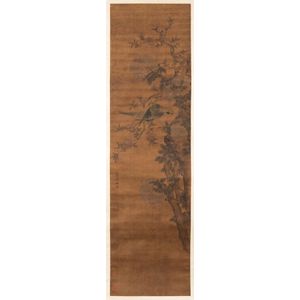Travelling Scholar Crossing Bridge in Ming Dynasty Landscape Painting
You must be a subscriber, and be logged in to view price and dealer details.
Subscribe Now to view actual auction price for this item
When you subscribe, you have the option of setting the currency in which to display prices to $Au, $US, $NZ or Stg.
- Ming Dynasty - The Ming Dynasty was a ruling dynasty of China from 1368 to 1644. It succeeded the Yuan Dynasty and preceded the Qing Dynasty. The Ming Dynasty was established by Zhu Yuanzhang, a former Buddhist monk who became a rebel leader and eventually overthrew the Mongol Yuan Dynasty. During the Ming Dynasty, China experienced a period of relative stability and prosperity. The government was centralized and bureaucratic, with the emperor at the top of the hierarchy. The Ming Dynasty is known for its cultural achievements, including the development of porcelain, the invention of movable type printing, and the construction of the Great Wall of China.
- Rustic - Rustic is defined as "of, relating to, or typical of country life or country people", and the items illustrated in this price guide accord with that definition.
But in the 18th and 19th century "rustic furniture" had a narrower definition. It referred to furniture where the framework was carved or moulded to resemble tree trunks and branches, and was usually for outdoor use. Rustic furniture was made in cast iron, wood, terracootta and concrete. Much of the Coalbrookdale company's cast iron furniture was of rustic design.
This item has been included into following indexes:
- Chinese antiquities by dynasty - Ming Dynasty 1,266
-
Chinese art
- landscapes 208
- painted scrolls 457
Visually similar items

A framed Japanese painting, attributed to Kano Tanshin (1653-1718), depicting two scholars riding horses under a peach tree, ink on silk, signed, one seal of the artist, 38 x 66.3 cm. Provenance: An old private Sydney collection, (1653-1718)

Albert Fullwood (1863-1930), Gabo Island, N.S.W 1891, watercolour and ink, initialled and dated lower right: A F 91, titled lower left, 14 x 18 cm,

Li Peiwen, mountain landscape, ink on silk, hanging scroll, 105 cm x 50 cm. Provenance: NSW private collection, acquired as one of 13 scrolls from (Joseph) Newman's Antiques on 22 July 1960 and hence by descent

A Chinese hanging scroll, signature of Shen Quan (1682-1760), ink and colour on silk, two seals of the artist, 172 x 48 cm
